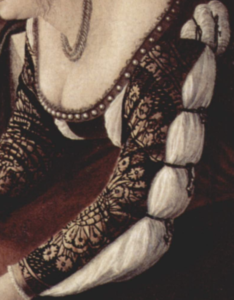A Study of 1490s Venetian Sleeves for Women
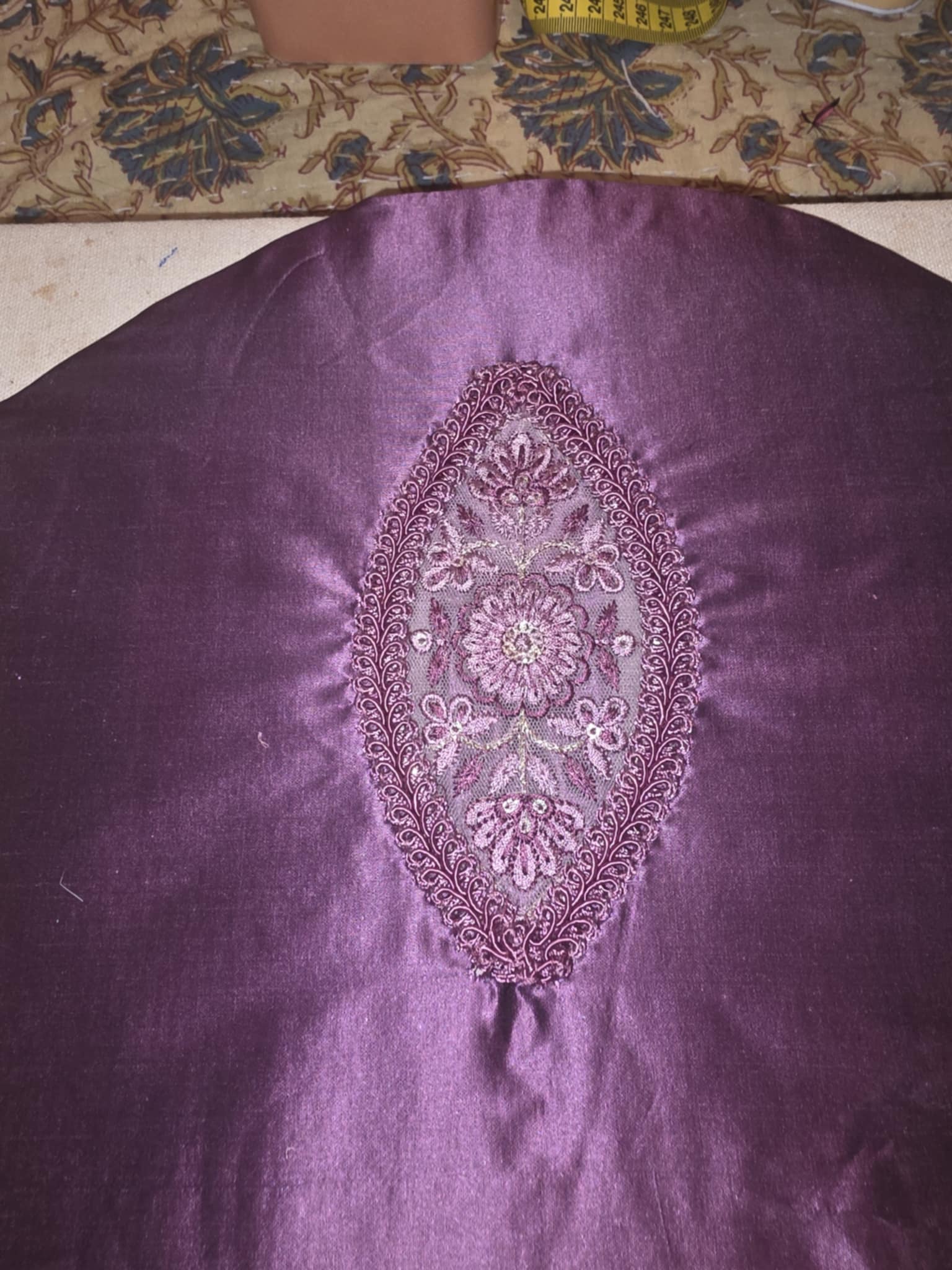
In Venice in the 1490s, a woman’s outfit included several layers. The body linen, the underdress, the overdress, and sleeves. The overdress was required out of the house, but could be foregone within one’s home. However, sleeves appear to have always been present. Sleeves were an accessory as well as a required garment layer. As the sleeves laced or tied on to the dress, it was possible to change an outfit by simply changing which pair of sleeves you wore with it. There were also a multitude of sleeve styles during this decade.
My goal is to try to recreate several sleeve variations based on various paintings from this time period.
The first set of sleeves I selected to make were based off of the painting The Giving of the Ring or An Engagement which was painted by Michele da Verona. The painting is dated 1495-1500. It is currently housed at Berlin, picture gallery (“Berliner Wunder”), foyer.
A close-up of this painting shows the sleeve style I worked on first. This is a sleeve that starts at the shoulder point and is continuous to the wrist. It is rather tight fitting, but does have openings to poof the body linen through at both the back of the elbow and the forearm. It does not appear to be overly stiffened to hold its shape.
To make the pattern for this sleeve, my Laurel Magistra Vittoria helped me by creating a duct tape cast of my arm wrapped in a garbage bag. We used my right arm as it is incrementally bigger than my left. From there, we cut the cast off up the front and back edges of my arm. We traced and ‘civilized’ these cast pieces to form a first draft of the pattern.
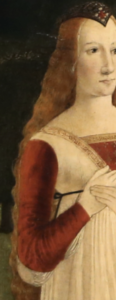
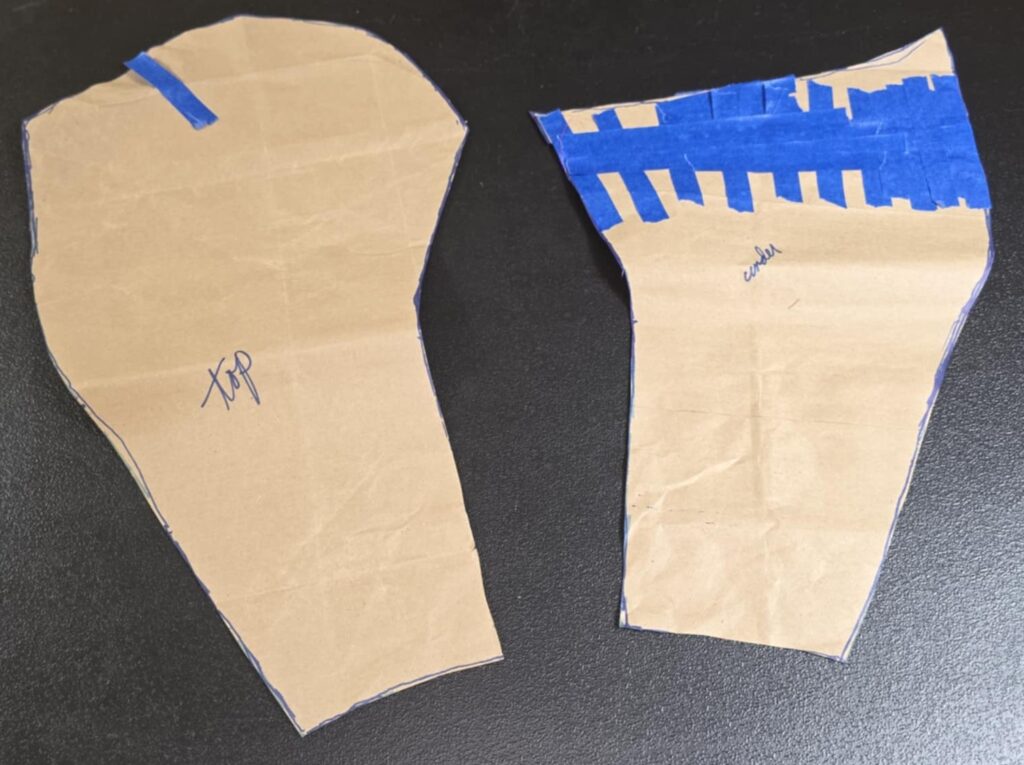
Once I had the first draft of the pattern, I cut out a mock-up and tested the fit, and adjusted from there a little with the length of the sleeve at the wrist. Once my pattern seemed to fit correctly, I transferred those changes to my paper patterns.
For this set of sleeves, I went with an inner layer of a single layer of heavy linen canvas for both the inside and outside of the arm pieces. I flat-lined those with quilting cotton for the lining. I then wrapped my outer fabric, a green silk called cerignola from Silk Baron, around the structural layers and hand whip-stitched it to the lining.
I then whip-stitched the inside and outside pieces of the sleeve together from the inside of the sleeve. I left breaks at the elbow and wrist for the body linen to poof through.
My sleeve attachment method–while not perfectly period– does allow me to quickly get dressed with minimal help. My sleeves have multiple corded loops at the sleeve head that wrap around buttons that are attached to the underside of the underdress’s straps. I finished these sleeves the day before an event and only had a few purple cords on hand so the loops currently on these green sleeves are temporary until I can find or braid a proper green-colored cord. Because of the temporary nature of these ties, they are not sewn to the silk at the very top of the sleeve but further down to the quilting cotton lining as once I put a needle in the silk, that hole will never go away. This causes the odd gapping you see in the sleeves when worn.
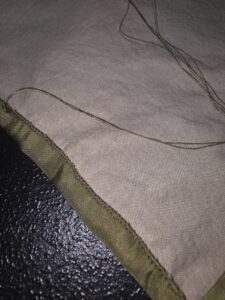

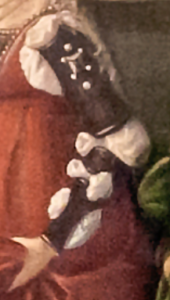
The next set of sleeves I am making are based on the Encounter and Departure of the Betrothed which was painted by Vittore Carpaccio, dating to approximately 1495 to 1500 which is currently housed at Gallerie dell’Accademia.
A close up of the figure shows an upper and lower sleeve. The upper sleeve has a detail below the shoulder cap, perhaps pearls or some other adornment such as a cutout. The lower sleeve features round cutouts that the body linen is pulled through.
For these sleeves, I made a lower sleeve pattern based on measurements I took of my wrist and closed hand for the lower edge, my upper forearm below my elbow for the top edge, and the overall length of my forearm for the length of the sleeve. The upper sleeve pattern I modified the pattern from the first sleeve to only have an upper section.
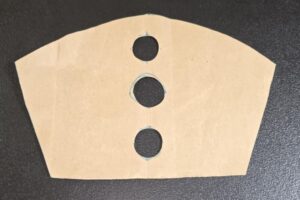
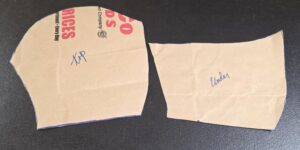
For the lower sleeve, I quilted 3 layers of linen canvas at ⅛ inch increments. I flat-lined that with a layer of quilting cotton for the lining. I then wrapped it with the silk and whip-stitched it to the back. I then used a half-circle leather punch to make the circular cutouts. The middle cut-out is 5 mm larger in diameter than the upper and lower cutouts. I then cut bias tape out of my silk and bound these cutouts. I then whip-stitched the edges together, from the inside of the sleeve. The lower sleeves will be laced to the upper sleeves. The body linen will be pulled through the cutouts and between the upper and lower sleeve that are laced together.
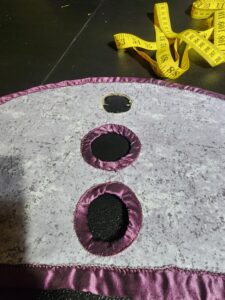
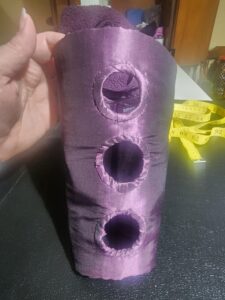

For the upper sleeve, I quilted 3 layers of cotton canvas at ⅛ inch increments. I flatlined that with quilting cotton to be the lining and then wrapped that with the silk and whip-stitched it to the back. The the upper arm detail, I went with an applique. I cut one the the lozenge motifs from the underdress’s hem trim and applied that to the upper arm. Around the edge, I hand tacked gimp braid in the same color down around the lozenge of trim. I then whipped the 2 upper sleeve pieces together from the inside of the arm. The sleeves will attach to the button mechanism on the underdress as described with full length green sleeves.
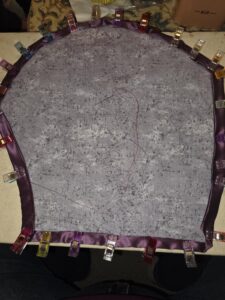
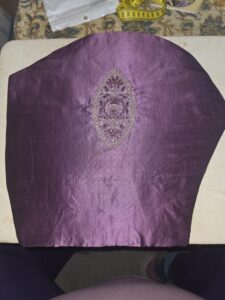
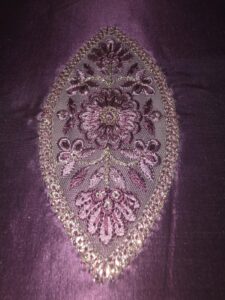

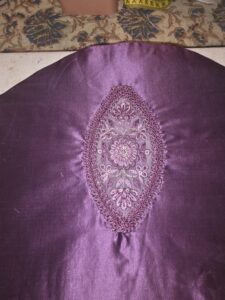
The third set of sleeves I am planning to make are based on one of the figures in the painting Two Venetian Ladies painted by Vittore Carpaccio, dating to approximately 1490. It is currently housed at Museo Correr.
The close-up of the figure in the front of this painting shows again a single sleeve that extends from shoulder cap to wrist. This sleeve is open on the outer back edge and tied in several places to keep it closed around the arm. The fabric is patterned like a brocade.
For this set of sleeves, the pattern from my green sleeves will be altered slightly to allow for a larger gap that can then be laced closed around the arm. These sleeves will be made in the lilac and silver brocade of the overdress.
